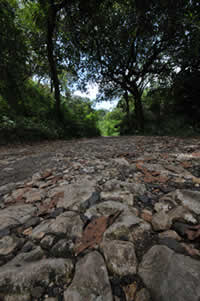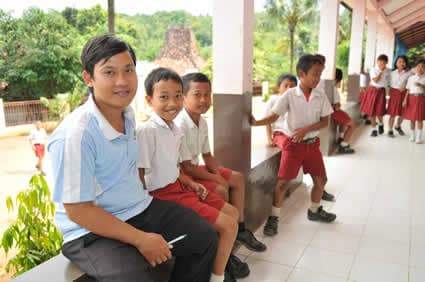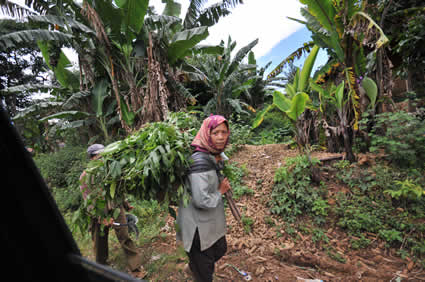The poor need hope.
My initial question for Samuel, a worker at the Kasih Abadi Student Center in Indonesia, is:
“What is the most relevant thought you have about your work?”
Samuel tries to think of the answer. Silence occurs and it creates a funny, awkward feeling.
I was interviewing the child development center staff for a church impact story, and these interviews sometimes bring an uneasy situation. To get an answer to a question like this may lead to an odd situation. It’s normal though.

“The poor need hope.”
To my surprise Samuel’s few words will become the focal point as he begin to shares his story of ministering to the poor.
Community development and growth is not just about numbers and statistics. Somewhere in the corner of real life, there is always a group of people who are missed.
They are stuck without any options.
For these people, community development becomes a hostile environment. They are silenced by the failure to see a better way out of their current life. Their children will soon believe that their future is already set.
They are not able to speak for themselves, and dream of a better way of living.
That has happened in Ngandong. This remote village has somehow been cut off from the outside world and for one reason — the road structure there is severely damaged.
This has been a problem for years, ever since the village was established.
And not because the government avoids building street access, but because the roads are easily ruined by rainwater and river streams within a few months after they are finished, leaving a huge potholes and big rocks blocking the only access in and out of the village.
This situation is affecting the education level in the village. The people in Ngandong have not enjoyed the privilege of advanced education like the other villages nearby.

Mr. Pandono is one of the few educated members of the village who has survived this hardship. He is a member of the church committee for the Kasih Abadi Student Center in Ngandong.
“In the 70s there was only six elementary students in my class from the whole village. I’m the only one who was lucky enough to continue to study through junior high school.”
Ngandong’s situation is now better than in the 70s, with four elementary schools available in the village. This has given villagers the ability to send their children to elementary school without worrying about walking a long distance.

But after the children finish elementary school, the village doesn’t have a junior high school for them. Only a few of the children dare to go to secondary school, which requires an 18 kilometer walk back and forth to reach the school. We are talking about the 21st century, and yet the people of Ngandong still have no access to a better education.
For most parents, the trip to the school may seem death defying, but those trips usually only consist of a quick drive or a walk to the school gates. But the families of Ngandong village, in central Java, Indonesia, take their lives in their hands every day walking to school. These trips involve navigating a narrow road through the forest for hours just to get to a secondary school.
The nearest junior high school is a local private school, and the public school takes at least two hours for the children to walk one way to reach it.
The nearest senior high school is 30 kilometers away in the town of Kudus, which because of the distance will reduce the number of children who can afford to go that far.

In the past only a few children from wealthier families in Ngandong have had the privilege to further their studies.
Villagers have been trying to rebuild and maintain the road structure, but their limited efforts feel like hitting the air. The road remains severely damaged. The last government intervention that the villagers can remember was seven years ago, and did not make a difference. Seems the government is also tired of dealing with these roads.
As soon as we enter the road leading to Ngandong village, white limestones replace the asphalt surface. Village officials feel helpless about repairing these roads every year. Their efforts to provide a decent road get wiped away as soon as the rain pours.
Big holes will get worse during the monsoon. Villagers try their best to fill in the gaps with smaller rocks and soil, but this fix may only last for a week. Trucks are the only reasonable vehicle that can navigate these harsh road conditions.
Trucks are mostly used by farmers to bring their crops from the village to the market. The richer farmers have their own trucks, while many other farmers have to carry their crops on their shoulders to the market.

Those who have money can rent a truck for the day. Sadly, none of the truck owners are willing to dedicate one of their trucks to be a local public transport.
The road conditions in Ngandong are a concern for the child development center in Ngandong. The center’s staff notice that teens have difficulty maintaining their attendance at the center. This is because they are too tired after the long walk to and from school.
When the center staff noticed that three of the secondary school students got sick after a long walk to and from school, the church in Ngandong stepped in.
The church committee knows that the lack of attention to Ngandong’s roads from local government is far from improving.
“The children cannot wait until the roads are fixed or public transport available. Therefore we want to take measures to prevent these children from ending up hopeless.”
A discussion between the church and Compassion staff concluded that we need to provide a way to fix the transportation problem.
Hiring a truck owner to provide the school transportation seemed to be the best choice. The church staff agreed to negotiate with the truck owner about the fees. We would use the truck not only to transport secondary students, but also other students along the way.
This requires an agreement from the community, as they will have to agree to contribute separately from what the church gives to the truck owner on monthly basis.

With God’s grace, one truck owner is willing to let one of his trucks to be used as school transportation in the morning and after school. The truck owner’s only concern — and why he never made steps to make one of the trucks available for public transportation before — is because there was no guarantee for monthly income and maintenance fees.
Samuel shares,
“We finally agreed to cover the basic expense of transport on monthly basis, while the truck owner also has the benefit to collect money from the other students who want to use the truck along the way.”
The church in Ngandong will pay 3 million rupiah a month (U.S. $300) or 130 thousand rupiah (U.S.$13) a day in fees to rent the truck. This will bring all of the sponsored children in secondary level to their school for free, every day. And the truck owner will earn additional income from other students who want to ride along the way.

The church’s action to subsidize transportation fees for sponsored children is part of a strategy to mitigate the high cost of transportation in the poverty-stricken village of Ngandong.
Samuel tells us,
“This move will benefit all the sponsored children who attend secondary school.”
Offering this transportation is a big ministry to Ngandong. So far, the church has established a good relationship with the villagers, but through this transportation intervention, the church once again has become a source of good will in the community.
The villagers notice the initiatives that come from the church. These initiatives have benefited them, and they no longer worry about how to provide transportation for their children.
This action is not only bringing benefit to the children from the church, but also to the entire community. Samuel shares again,
“The benefit is real. It will boost the motivation of children in Ngandong to further their studies.
“The poor need hope.”







2 Comments |Add a comment
What a great ministry! I loved this story!
This story makes my heart weep with joy! The things that can be accomplished when God works through his people. So glad God introduced me to Compassion!